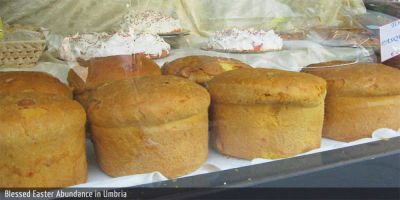Driving through the Umbrian countryside during the week prior to Easter, you’d note whiffs of smoke drifting up from the outdoor, stone bread ovens fired up by the farmwomen. Holy Week for the Umbrian farmwomen is a busy one, an exhausting one. Making the torta di Pasqua (“Easter cake”) or pizza pasquale, as it is often called, in the stone bread ovens is a major task. The traditional Easter cake or pizza is a raised cheese bread made of eggs, flour, olive oil, salt, pepper, and three kinds of cheeses: parmigiano, pecorino and groviera.
When we farmed back in the 1970’s, most of our neighbors were mezzadri, share-croppers, and cash was scarce. Gifts were often foods made from what they could grow on the land. At Eastertime, the farm families thanked the doctor, the landlord and any other townspeople with cheese breads. I remember our farmwoman neighbor, Mandina, beginning to set aside eggs from her chickens, ducks, geese, and even guinea fowl just after Carnevale, hoping she’d be able to accumulate enough eggs for the making of the torte di Pasqua. I remember Mandina searching the hills for delicate, wild salad greens and scrambling in the woods for the first wild asparagus in the springtime: both fetched good prices at the outdoor market in Assisi and the coins earned were spent at the nearby grocer on the cheeses. Certainly, the pecorino cheese came from the five or six sheep each Umbrian farmer raised, but the other cow’s milk cheeses had to be bought. Most farmwomen made over 20 huge torte di Pasqua which required over 100 eggs in addition to the kilos of cheeses.
I always missed the mixing and kneading of the mountains of flour, the mounds of grated cheese and dozens of eggs as the farmwomen always started the torte di Pasqua preparation before first light. I was lucky enough to be at Mandina and Peppe’s farm one Holy Thursday, though, to see the huge mushroom-shaped loaves come out of the outdoor stone oven. The unusual baking tins gave that characteristic shape to the torta di Pasqua: farmwomen used large sardine cans because cake tins were too expensive. As the dough rose during the baking, it came up and out over the edges of the tin.
When the Easter breads had baked to a golden color, Mandina shoved a huge wooden paddle into the oven and slid out each torta placing it carefully on a long wooden board propped on two logs nearby. How I wish I had a photo of Mandina cautiously walking up the stairs to her kitchen with a wooden board bearing eight to ten breads carefully balanced on her kerchiefed head!
On Holy Saturday, the blessing of the homemade torte di Pasqua took place in the countryside churches and small chapels. The age-old tradition lives on. The farmwomen head to the church closest to home, dressed in their best and carrying huge baskets holding the cheese bread. Nestled in the basket around the cheese breads are salami, homemade red wine, one hard-boiled egg for each person in the home, and a pinch of salt. The blessed foods will be shared at the Umbrian Easter breakfast the next morning.
Then and now, the torte di Pasqua are lined up in the windows of pastry shops and bakeries here in Umbria in the weeks before Easter. Townspeople head to the bakeries a couple days before Easter to book their torte - if they are not lucky enough to receive one from a nearby farm family.



